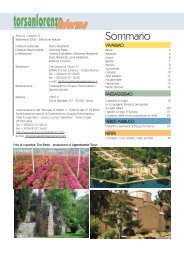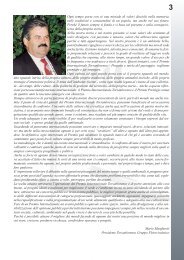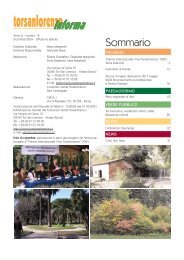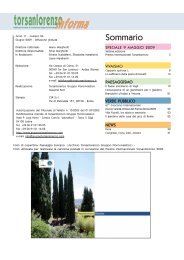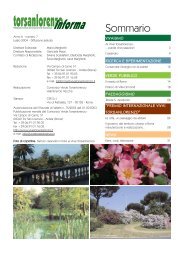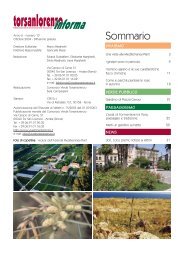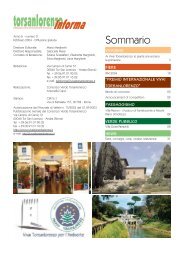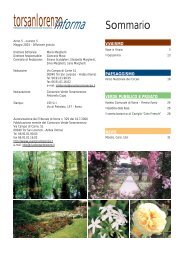Vivaismo Verde Pubblico Paesaggismo - Torsanlorenzo Gruppo ...
Vivaismo Verde Pubblico Paesaggismo - Torsanlorenzo Gruppo ...
Vivaismo Verde Pubblico Paesaggismo - Torsanlorenzo Gruppo ...
You also want an ePaper? Increase the reach of your titles
YUMPU automatically turns print PDFs into web optimized ePapers that Google loves.
A brief history of the Missouri Botanical Garden<br />
Joseph M. Schuster, Missouri Botanical Garden Public Relations Staff<br />
Photos by Missouri Botanical Garden<br />
One day in the spring of 1819, 18-year-old Henry Shaw,<br />
an Englishman recently landed in the river town of St.<br />
Louis on the edge of the American wilderness, took a<br />
half-day journey on horseback out of town. Riding<br />
westward through marshy ground, past sinkholes and<br />
Indian burial mounds, he came at last to a narrow path<br />
cutting through brush, and found himself on elevated<br />
ground overlooking a prairie. “Uncultivated,” he<br />
recorded, “without trees or fences, but covered with tall<br />
luxuriant grass, undulated by the gentle breeze of<br />
spring.”<br />
If ever a man loved a piece of ground, it was Shaw.<br />
Shaw’s fortunes grew, he resolved to return something<br />
to his adopted city, and 40 years after his arrival in St.<br />
Louis, he opened on the land he so loved a botanical<br />
garden for the city’s residents. This garden is today the<br />
Missouri Botanical Garden. One of the oldest botanical<br />
gardens in the U.S., Missouri Botanical Garden is outstanding<br />
not only in the excellence of its displays, but<br />
also in the richness of its architectural heritage and the<br />
importance of its botanical research.<br />
Garden founder Henry Shaw came to St. Louis in 1819<br />
to open a business selling hardware and cutlery. As St.<br />
Louis flourished in the second quarter of the 19th century,<br />
and the city’s population grew, Shaw’s business<br />
expanded to include investments in agricultural commodities,<br />
mining, real estate, and furs.<br />
Shaw’s business success provided him with a substantial<br />
fortune and allowed him to retire by 1839. He was<br />
not yet 40. During the next decade he continued buying<br />
property. His eventual holdings of about 1,000 acres<br />
included the land he had seen his first year in St. Louis.<br />
On this land he had a country home built. From 1849 to<br />
1851 he also traveled extensively in the United States<br />
and Europe.<br />
By the 1850s Shaw had resolved to spend the remainder<br />
of his life in acts of philanthropy and began to provide<br />
a great deal of support to develop many St. Louis cultural<br />
and social institutions.<br />
Shaw also had a strong interest in botany and gardening,<br />
fostered by early years at Mill Hill School, located<br />
on the former estate of English botanist Peter Collinson.<br />
It was not surprising, therefore, that one of his trips to<br />
England inspired him to give the people of St. Louis a<br />
garden like the great gardens and estates of Europe.<br />
Shortly after 1851 Shaw began development of a tenacre<br />
site near his country home. His unusual gesture<br />
presaged the age of American philanthropy and the cre-<br />
Chinese Garden<br />
ation of the great U.S. public parks by several decades.<br />
The news that Henry Shaw was building a botanical<br />
garden reached Dr. George Engelmann, a German<br />
physician-botanist who had come to the U.S. several<br />
decades earlier. Engelmann, one of the great early<br />
American botanists, suggested that the garden be more<br />
than a public park, that it become involved with scientific<br />
work like the great botanical institutions of Europe.<br />
With the assistance of Harvard botanist Asa Gray and<br />
Sir William Hooker, director of the Royal Botanic<br />
Gardens at Kew, near London, Engelmann persuaded<br />
Shaw to include a herbarium (collection of botanical<br />
specimens) and a library in his garden. Shaw in turn<br />
encouraged Engelmann to buy specimens and books in<br />
Europe.<br />
The Missouri Botanical Garden opened to the public in<br />
1859 and began to grow in the European tradition of<br />
horticultural display combined with education and the<br />
search for new knowledge.¹ Today, 148 years after<br />
opening, the Garden is a National Historic Landmark; a<br />
24 torsanlorenzo<br />
Informa



